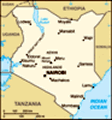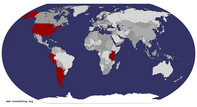Advertisement
Published: October 28th 2015
After getting a great nights sleep and a hearty breakfast we met up with Francis to head in to the park. We headed out from the lodge at 8:00 and returned at 4:30. The inbetween was a spectacular, unbelievable, amazing day of wildlife viewing.
The pictures attached probably will tell the story better than any words, but we'll try.
There are no real roads in Maasai Mara. Just a bunch of dirt off road trails. Some more heavily travelled than others.
We started off the day with photographing some Gazelles, Impala, Wildebeest, Topi, Warthogs, and Zebra. We heard some Elephants in the woods but couldn't see them. Then we crossed paths with three hyenas. Sarah called them cute and Francis told her how their jaws were the strongest in Africa and watching them devour an animal was pretty disgusting.
We continued on seeing an Ostrich and then a Lioness. The Lioness was resting under a bush and was probably 30 yards away. Francis didn't let us watch her long and we soon found out why.
Just up the dirt trail there were 2 or 3 vans parked around an Impala. A dead Impala, with its hind
quarters ripped open. The Impala was a male with big antlers and was about the size of a large deer. We came around a bush and the whole scene unfolded. There in the shade of the small bush was a big male Cheetah desperately panting, trying to catch its breath. The Cheetah had recently taken down the Impala and was too exhausted to eat yet. We watched the Cheetah for 10 minutes or so and Francis suggested we come back later to see if the Cheetah had recovered from its kill. Francis explained that the Cheetah attack the hind legs and when they are able to get the Impala down they suffocate the animal or break its neck. It wasn't clear how the Impala died.
Fortunately there was a herd of Giraffes maybe a half mile away. There were three kinds of Giraffes all foraging together. The only specific type I can name is the Maasai Giraffe which is the tallest and has a darker color.
Back to the Cheetah. By now the first two vultures were on the ground nearby and several more were circling overhead. The Cheetah was still catching its breath. We hadn't been back
for more than 2 minutes when the Cheetah got up and dragged the Impala over to his somewhat shaded spot by the bush. We have an incredible video of that scene in action. Having now recovered enough from the kill to eat the Cheetah dug in to the hind quarters. He would stop every minute or so, get up and look around. Francis explained he was on the lookout for the Hyenas who could smell blood from 5 km away. If the Hyenas showed up, the Cheetah would have to move on or may be killed.
The scene really wasn't disgusting to Sarah and myself, although we didn't focus on the bloody parts.
We left the Cheetah and went back to the Lioness. We searched for the likely nearby male but no luck. Back to the Cheetah for a little bit. Now there were dozens of vultures nearby. We only stayed another minute and then it was off to see what else we could find.
A short while later Francis got a tip from a nearby van of a Leopard spotting, Francis' favorite animal. We zoomed over and two other vans were searching a brushy area. We
got a very brief glimpse of the Leopard before it disappeared in to the brush.
4 of the Big 5 down. Elephants to go.
And it sure didn't take long. Maybe 15 minutes later we spotted a group of 4 Elephants cruising along. They were out in an open field and looked to be heading to a grove of trees, likely for water. There was a large adult, two juveniles and a baby. I was amazed by how close we were able to get. Maybe 20-30 yards and they didn't seem bothered in the least.
None of the animals except the Warthog seem bothered by our presence. The animals detour their path a little and move out of the road when we drive through, but none seem irritated. It's like we are just another big beast roaming the wild with them. The Warthogs find us annoying as they always run away with their tail straight up in the air as if expressing their disgust.
At this point it may have been around 11:00. Yes 11:00 on the second day and we had already seen the Big 5 and so much more! This is the time in
the trip where my father, somewhat jokingly, would suggest we call it a day because it can't get any better.
Of course we didn't call it a day. The goal for the day was to get to the Maasai Mara river, the site of the famous Wildebeest migration crossing and we were getting closer.
Next we found an Eland, the largest of the Antelope. And then was our first male Lion. He was lazily sleeping away in the shade of some brush and didn't move a muscle. There was another Lioness nearby, again in the shade.
It felt like we were getting closer to the river because the concentrations of wildlife really picked up. There were so many more Zebras and Buffalo and Topi and all the other herd animals everywhere.
Next was a real treat. There was a bush right next to the road and Francis spotted something in it. There was a really tiny cat. A Tsavo Cat. They are common in Tsavo National Park but not as much here. The cute little guy disappeared further in to the bush fairly quickly.
We saw some more elephants, giraffes, wildebeest and baboons. Then 3
pregnant Lionesses all huddled together under some trees. We were no more than 10 yards away.
How close the animals would let us get is shocking. It is somewhat similar to the Galapagos in that way.
After showing us the world's smallest antelope, the Dick-Dick, we finally settled for lunch on the side of a small hill overlooking The Great Migration. The Great Migration had come and gone(July-early September) but he described the millions of wildebeest moving across the land and having to cross the river.
Just before getting to the river we saw another Lioness and a good sized male Lion but both were asleep...as usual...
We then came across a new animal, the Mongoose. Francis described the Mongoose and their hunting of snakes.
When we got to the river there were tons of Hippos and some good size crocodiles. With the shear walls of the river banks it was easy to envision the scene from The Great Migration. Another sleeping big male lion lay in some brush along the river bank.
And then, finally, camped out in some shade was a large male Lion...awake! Although he was still laying down. We were
able to get within 10 yards of him. He was so impressive with his massive head and mane. Truly majestic. He had a presence about him and it was easy to understand why he is called king.
By now it was probably 2:00 and we were far from the lodge so we started driving back. We were starting to get used to all the animals so we didn't stop nearly as often as we did on the way to the river.
Whenever vans pass each other the drivers almost always stop and talk in Swahili. Sometimes you can see they are telling each other where they have seen animals. Other times it seems like they are just chatting.
After one of these exchanges Francis told us we were going to go off the road and to be ready to take some photos very quickly and then had to get back to the road. A hundred yards off the road was a mother Cheetah and 4 cubs. They were all alert and hanging out in the shade.
Francis said that the men in the van who told us where to find the cheetahs worked for a non-profit
organization that is trying to protect the animal. These cheetahs have trackers and the men had just checked in on the cheetahs before we passed them on the road.
Cheetahs have been heavily poached and their populations have been suffering especially due to wealthy people who take the cubs to raise as pets. Apparently if you get the cub young enough they can be domesticated like a normal house cat.
Francis told us a wealthy American woman took a liking to the Cheetah and has been trying to save them over the last 4 years. By putting trackers in the Cheetah they are able to find poachers, and as a result poaching has gone down significantly. It is a big deal to get caught poaching and now poachers don't know whether or not a Cheetah has a tracker. So as a direct result of this one wealthy individual (we will need to Google her), the Cheetah populations are coming back strong and Francis, who has been guiding for 15 years, sees the direct result in the park. What an amazing way to do good with your wealth.
We saw some more Hyenas and then watched a big
group of Elephants eating. And the final treat for the day were a group of adult Ostriches with about 12 babies. Francis shrieked with joy so we know it was a rare site. He told us that all the adults work together to protect the little ones.
Back to the lodge around 4:30. Cleaned ourselves up, had some dinner and early to bed as our game drive in the morning starts at 6:00.
*note that a lot of our photos are on an SD card we can't use with the tablet we are typing these blogs on. Technology oversight on our part. We'll add them when we get home or make a separate post. Not having the male lion photo for this post is especially a bummer.
Advertisement
Tot: 0.251s; Tpl: 0.013s; cc: 5; qc: 46; dbt: 0.2215s; 1; m:domysql w:travelblog (10.17.0.13); sld: 1;
; mem: 1.2mb














